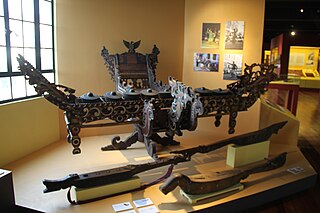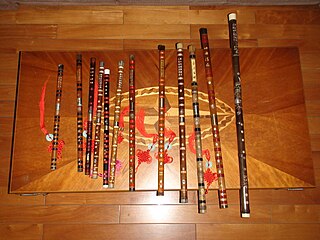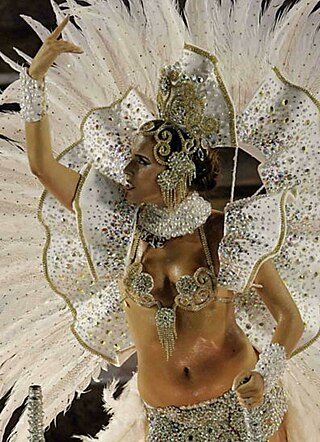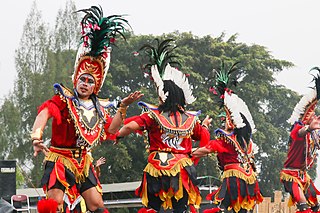This article needs additional citations for verification .(December 2016) |
Jember is a regency of East Java province, Indonesia.
This article needs additional citations for verification .(December 2016) |
Jember is a regency of East Java province, Indonesia.
Patrol is one of the traditional music arts that became famous and spread in East Java, especially at Jember. Patrol uses a simple musical instrument, that is the kentongan. Patrol uses various sizes of kentongan and it is sounded regularly to produce a beautiful and pleasant tone to be heard. Besides using the kentongan, the player may be accompanied by the seruling. (It is what makes the difference between Patrol Music with Tongtong Music from Madura which uses saronen as wind instruments.)
Patrol started from Jember people's habits in the past when they liked to keep pigeons. From that habit, some people became accustomed to percussion musical instruments. At first, it was only used for a method to call pigeons. When people who kept pigeons increased, these percussion musical instruments developed into a distinct rhythm. As time went by, Patrol developed to become a folk music and became a communication device. Then, Patrol also developed as the music of the plantation guards. Patrol developed further during the holy month of Ramadan to awaken the citizens at meal time (sahur), because the majority of citizens of Jember are Muslims.
Patrol is usually played in groups with various sizes of kentongan. Each size has a different tone, so the arrangement of each tone is very necessary in this Patrol Music. kentongan instruments are usually made of bamboo and wood. The ones which are made of bamboo are usually smaller in size and have a squeaky sound. When it made of wood, it should be bigger, the voice is deep, and loud as well. The patrol music performance needs both bamboo and wooden kentongan in various sizes to make a typical harmony of patrol.
A patrol music performance has all kinds of kentongan which collaborate to become one serving of a beautiful music instrument. Each performance usually brings some songs which are packed with the typical style of Patrol Music. The songs are usually folk songs, songs for playing traditional games, and even a modern one like dangdut or campursari. All songs which are performed are packaged in the style of Patrol music.
In Jember, there are many patrol groups, but each of them has their own creativity. It can be from the instrument, music arrangement, costume and performance. From the instrumental aspect, there some groups that added another music instrument such as jidor, ketipung, plastic drum, angklung, etc. They added the instruments as creation in order to make the sound more various and different from the other groups. From a costume aspect, each patrol group has their own creativity. They usually wear their regional dress, traditional clothes, or a costume from their own design in order to make their group more unique and interesting.
Before 2001, it can be said that Jember regency government paid less attention to the Patrol music. There was not much effort put forth by government to develop this traditional music. Neither training programs nor competitions were held by the government to attract the Jember artists interested in order to developing the cultural. Each specific event or Ramadan they played in their area. Realizing it through UKM artistic Jember University efforts to maintain and preserve the culture. On 7–9 November 2001, Art UKM Jember University first organized a music festival of patrol. Ultimately UKM artistic Jember University routinely held music festivals patrol. Starting from Jember University's main road, the Patrol group is started to play their music. After that they left one by one to wander the Jember streets and play music with the melodic patrol to awaken and accompany the residents until dawn.

Jember Fashion Carnaval is an annual event. In the tenth carnaval in 2011, over 600 participants walked along the world's longest catwalk. It ran for 3.6 kilometres (2.2 mi), along on Sudirman Street (Central Park) and Gajah Mada Street up to Jember Sport Hall. [1]

Gamelan is the traditional ensemble music of the Javanese, Sundanese, and Balinese peoples of Indonesia, made up predominantly of percussive instruments. The most common instruments used are metallophones and a set of hand-drums called kendang, which keep the beat. The kemanak, a banana-shaped idiophone, and the gangsa, another metallophone, are also commonly used gamelan instruments on Bali. Other notable instruments include xylophones, bamboo flutes, a bowed string instrument called a rebab, and a zither-like instrument called a siter, used in Javanese gamelan. Additionally, vocalists may be featured, being referred to as sindhen for females or gerong for males.

A shakuhachi is a Japanese longitudinal, end-blown flute that is made of bamboo. The bamboo end-blown flute now known as the shakuhachi was developed in Japan in the 16th century and is called the fuke shakuhachi (普化尺八). A bamboo flute known as the kodai shakuhachi or gagaku shakuhachi (雅楽尺八) was derived from the Chinese xiao in the Nara period and died out in the 10th century. After a long blank period, the hitoyogiri shakuhachi (一節切尺八) appeared in the 15th century, and then in the 16th century, the fuke shakuhachi was developed in Japan. The fuke shakuhachi flourished in the 18th century during the Edo period, and eventually the hitoyogiri shakuhachi also died out. The fuke shakuhachi developed in Japan is longer and thicker than the kodai shakuhachi and has one finger hole less. It is longer and thicker than hitoyogiri shakuhachi and is superior in volume, range, scale and tone quality. Today, since the shakuhachi generally refers only to fuke shakuhachi, the theory that the shakuhachi is an instrument unique to Japan is widely accepted.

As it is a country with many different tribes and ethnic groups, the music of Indonesia itself is also very diverse, coming in hundreds of different forms and styles. Every region has its own culture and art, and as a result traditional music from area to area also uniquely differs from one another. For example, each traditional music are often accompanied by their very own dance and theatre. Contemporary music scene have also been heavily shaped by various foreign influences, such as America, Britain, Japan, Korea, and India.

Kulintang is a modern term for an ancient instrumental form of music composed on a row of small, horizontally laid gongs that function melodically, accompanied by larger, suspended gongs and drums. As part of the larger gong-chime culture of Southeast Asia, kulintang music ensembles have been playing for many centuries in regions of the Southern Philippines, Eastern Malaysia, Eastern Indonesia, Brunei and Timor, Kulintang evolved from a simple native signaling tradition, and developed into its present form with the incorporation of knobbed gongs from Sundanese people in Java Island, Indonesia. Its importance stems from its association with the indigenous cultures that inhabited these islands prior to the influences of Hinduism, Buddhism, Islam, Christianity or the West, making kulintang the most developed tradition of Southeast Asian archaic gong-chime ensembles.

The shamisen, also known as sangen or samisen (all meaning "three strings"), is a three-stringed traditional Japanese musical instrument derived from the Chinese instrument sanxian. It is played with a plectrum called a bachi.

A bansuri is an ancient side-blown bamboo flute originating from the Indian subcontinent. It is an aerophone produced from bamboo and metal like material used in many Nepali Lok songs. A bansuri is traditionally made from a single hollow shaft of bamboo with seven finger holes. Some modern designs come in ivory, fiberglass and various metals. The six hole instrument covers two and a half octaves of music. The bansuri is typically between 30 centimetres (12 in) and 75 centimetres (30 in) in length, and the thickness of a human thumb. One end is closed, and few centimeters from the closed end is its blow hole. Longer bansuris feature deeper tones and lower pitches. The traditional design features no mechanical keys, and the musician creates the notes they want by covering and uncovering the various finger holes.

The dizi, is a Chinese transverse flute. It is also sometimes known as the di or héngdi, and has varieties including Qudi, Bangdi, and Xindi. It is a major Chinese musical instrument that is widely used in many genres of Chinese folk music, Chinese opera, as well as the modern Chinese orchestra. The dizi is also a popular instrument among the Chinese people as it is simple to make and easy to carry.

The angklung is a musical instrument from the Sundanese in Indonesia that is made of a varying number of bamboo tubes attached to a bamboo frame. The tubes are carved to produce a resonant pitch when struck and are tuned to octaves, similar to Western handbells. The base of the frame is held in one hand, while the other hand shakes the instrument, causing a repeating note to sound. Each performer in an angklung ensemble is typically responsible for just one pitch, sounding their individual angklung at the appropriate times to produce complete melodies.

The suling is a musical instrument of the Sundanese people in Indonesia. It is used in the Degung ensemble. Bamboo ring flute can also be found in Southeast Asian, especially in Brunei, Indonesia, Malaysia, the Philippines and Singapore.

The music of Myanmar shares many similarities with other musical styles in the region. Traditional music is melodic, having its own unique form of harmony, often composed with a 4
4 (na-yi-se), a 2
4 (wa-let-se) or a 8
16 time signature. In Burmese, music segments are combined into patterns, and then into verses, making it a multi-level hierarchical system. Various levels are manipulated to create a song. Harmony in Mahagita is known as twe-lone, which is similar to a chord in western music. For example, C is combined with F or G.

The Carnival of Brazil is an annual festival held the Friday afternoon before Ash Wednesday at noon, which marks the beginning of Lent, the forty-day period before Easter. During Lent, Roman Catholics and some other Christians traditionally abstained from the consumption of meat and poultry, hence the term "carnival", from carnelevare, "to remove meat."

The term Chinese orchestra is most commonly used to refer to the modern Chinese orchestra that is found in China and various overseas Chinese communities. This modern Chinese orchestra first developed out of Jiangnan sizhu ensemble in the 1920s into a form that is based on the structure and principles of a Western symphony orchestra but using Chinese instruments. The orchestra is divided into four sections – wind, plucked strings, bowed strings, and percussion, and usually performs modernized traditional music called guoyue. The orchestra may be referred to as Minzu Yuetuan or Minyuetuan in mainland China, Chung Ngok Tuen in Hong Kong, Huayuetuan in Southeast Asia, or Guoyuetuan in Taiwan.
The venu is one of the ancient transverse flutes of Indian classical music. It is an aerophone typically made from bamboo, that is a side blown wind instrument. It continues to be in use in the South Indian Carnatic music tradition. It is referred to as nadi and tunava in the Rigveda and other Vedic texts of Hinduism. In northern Indian music, a similar flute is called bansuri. In the south, it is also called by various other names such as pullanguḻal (புல்லாங்குழல்) in Tamil, oodakuḻal (ഓടകുഴൽ) or kurungu kuḻal in Malayalam (Kerala) and ಕೊಳಲು (koḷalu) or ಮುರಳಿ (muraļi) in Kannada (Karnataka). It is known as pillana grōvi or vēṇuvu (వేణువు) in Telugu. It is also called as Carnatic Flute.

A slit drum or slit gong is a hollow percussion instrument. In spite of its often being called a drum, it is not a true drum because it lacks a drumhead, the membrane stretched across the top of a true drum). It is classed instead as an idiophone in which the entire instrument vibrates, usually carved or constructed from bamboo or wood, in the form of a mostly closed hollow chamber with one or more slits in it. It is played by striking near the edge of the slit. In some designs, the slit is a single straight line; in others, the slit is used to create one or more "tongues", achieved by cutting three sides of a rectangular shape and leaving the fourth side attached. Most slit drums have one slit, though two and three slits occur. Tongues of different areas or thicknesses will produce different pitches. Slit drums are used throughout Africa, Southeast Asia, and Oceania. In Africa such drums, strategically situated for optimal acoustic transmission, have been used for long-distance communication.

The Barranquilla Carnival is one of Colombia's most important folkloric celebrations, and one of the biggest carnivals in the world. The carnival has traditions that date back to the 19th century. Four days before Lent, Barranquilla decks itself out to receive national and foreign tourists to join together with the city's inhabitants to enjoy four days of intense festivities. During the carnival, Barranquilla's normal activities are put aside as the city gets busy with street dances, musical and masquerade parades. The Carnival Of Barranquilla includes dances such as the Spanish paleo, African Congo, and indigenous mice y mica's. Many styles of Colombian music are also performed, most prominently cumbia, and instruments include drums and wind ensembles. The Carnival of Barranquilla was proclaimed a Cultural Masterpiece of the Nation by Colombia's National Congress in 2002. Also the UNESCO, in Paris on November 7, 2003, declared it one of the Masterpieces of the Oral and Intangible Heritage of Humanity, and it was during Olga Lucia Rodriquez Carnival Queen year.
The sogeum is a small bamboo transverse flute used in traditional Korean music. Unlike the larger daegeum, it does not have a buzzing membrane. It is used in court, aristocratic, and folk music, as well as in contemporary classical music, popular music, and film scores.

The gourd mouth organ is a free reed mouth organ played across East and Southeast Asia. It consists of a gourd wind chest with several bamboo or bronze pipes inserted on top of it, the numbers of pipes differing from region to region.

Jember Fashion Carnaval or JFC is an annual carnival held in the East Java city of Jember. Officially it is written as Jember Fashion Carnaval; the word carnival here is officially spelled as carnaval, probably a confusion with Indonesian spelling karnaval, or an influence of the Dutch spelling carnaval. Jember Fashion Carnival has no relation with the Christian pre-Lenten festival, but more of a festivities in general, roughly following the Brazilian style, with procession of dancers in extravagant costumes, with emphasis on the traditional Indonesian motif.

Music of Minang is a traditional and living genre of Indonesian music that grows and develops in the Minangkabau culture area. Music whose origins are related to Malay Music is generally played by musical instruments such as Talempong, Saluang, Minang rebab, Serunai, Tmbourine, Aguang, Gandang, and Violin. Minang music is also played to accompany various dances such as the Pasambahan dance and the Piring dance.

Ireng mask dance also known as Topeng Ireng or Dayakan is a traditional Javanese art that developed in Magelang Regency, Central Java, Indonesia.